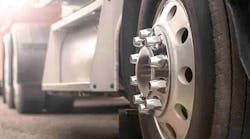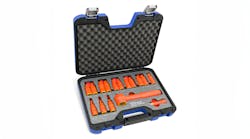Tire pressure monitoring systems (TPMS) and automatic tire inflation systems (ATIS) are crucial to preventing potentially disastrous tire issues. TPMS does this by monitoring tire pressure and temperature and alerting drivers and/or the fleet when complications occur. ATIS, on the other hand, handles tire pressure on its own by inflating or releasing air as necessary when tires go over or under specified air pressure levels.
Both systems have advantages and disadvantages. By understanding the differences between them, how they can improve maintenance costs and downtime, and the future of tire pressure monitoring and management, fleets will be able to choose the best system to suit their needs.
TPMS versus ATIS
As far back as the 1970s, the National Highway Traffic Safety Administration (NHTSA) has looked at the benefits of TPMS. It wasn’t until 2000, however, that the U.S. Congress officially mandated that passenger vehicles weighing under 10,000 lbs. must be equipped with TPMS. This became known as the Tire Recall Enhancement, Accountability, and Documentation (TREAD) Act of 2000. The act was to go into effect for all light passenger vehicles sold on or after September 1, 2007.
Currently, no laws exist enforcing medium or heavy duty fleet vehicles (Classes 3-8) to have any sort of tire pressure monitoring or management system installed on their vehicles – only light duty fleet vehicles (Classes 1 and 2) are affected by the TREAD Act. However, by utilizing the TPMS technology, fleets are able to extend tire life, increase fuel economy, reduce maintenance costs, and improve safety.
While most light vehicle TPMS sensors only monitor pressure, commercial vehicle sensors include more.
“Tire pressure monitoring systems [in commercial vehicles] have a sensor that monitors pressure and temperature in each tire and wheel assembly and identifies the wheel position on which they are installed,” explains Peggy J. Fisher, president of commercial vehicle TMPS provider TireStamp Inc. “They wirelessly communicate to the driver when problems arise, [and] if the TPMS is integrated into a telematics service, alerts are sent to the fleet. More advanced TPMS 2.0 systems send alerts to the fleet, provide useful reports, and enable managers to get a fleet-wide overview of the health of their tires.”
Having this information is crucial because it gives fleets the knowledge they need to prevent issues before such issues become critical, helps predict their future tire needs, and assists with assessing the type and quality of the maintenance being done on tires.
Though the information gathered through TPMS is extremely beneficial, the downside is that someone still needs to step in and make the fix.
“TPMS is valuable to a certain customer who wants the awareness while also maintaining the control of doing the maintenance themselves,” says Lee Alexander, category director, ITMS, for Stemco, a manufacturer of heavy duty components and solutions for the commercial vehicle market. “These fleets that use TPMS usually have their own maintenance facilities and aren't driving long, remote routes where they could get stranded.”
In general, TPMS tends to be less often specified than ATIS among commercial vehicles. Much of this comes from the convenience ATIS provides by automatically inflating or releasing air when tires fall above or below the specified levels of inflation. Part of this preference may stem from previous challenges with TPMS products.
“Early TPMS products failed to satisfy fleet requirements since they only delivered alerts to drivers, who usually ignored them, and were initially plagued with sensor problems that resulted in a distrust of these systems,” Fisher says.
Problems also occurred with TPMS sensors involving either the signal, battery life, or maintenance.
“There are two primary types of sensors – internal sensors mounted to the wheel inside the tire, and valve stem cap sensors,” says Steve Miller, vice president of engineering at Pressure Systems International (PSI), a provider of automatic tire inflation systems for commercial vehicles.
Internal sensors can be problematic because they can get lost during tire replacements and may also increase the need to remove the tire from the vehicle when a sensor battery is low. However, this type of sensor is theft- and damage-resistant, whereas valve stem cap sensors are not. Cap sensors also require removal from the valve stem in order to add air to the tire, which creates an inconvenience whenever access to the inner tire is necessary.
It is estimated that around 60 to 70 percent of fleets use ATIS over TPMS, notes Howard Fromm, senior product manager at Meritor, a manufacturer of automobile components for military suppliers, trucks, and trailers.
“ATIS is more commonly specified to trailers because [trailers] are typically stored and pooled in yards around North America – in much higher numbers than tractors – where there is no access to maintenance,” Alexander says.
With little access to maintenance, having a tire management system like ATIS can help keep a fleet running with as little downtime as possible.
When it comes to specifying ATIS on the drive and steer tires, the technology isn’t quite as advanced.
“Drive axles present significant design challenges in routing the air through the drive axles and through the wheel-end,” Miller explains. Product development is ongoing, and not yet ready for the commercial vehicle market. “Hub-mounted systems exist but require the vehicle to be in motion before delivering air to an underpressurized tire, so one must drive on an underinflated tire, which is what you are trying to avoid in the first place.”
There are additional challenges with the specification of ATIS on steer axle tires, Miller notes. Routing the air through the steering knuckle as well as potentially damaging exposure of the airlines on steer axle wheels are issues still in need of solutions. But it is likely these steer axle issues will not be fixed until a remedy is found for the challenges with drive axle tires.
Although ATIS is the preferred system for many fleets compared to TPMS, it also has its drawbacks. When the ignition is turned off, or the trailer is not connected to the tractor, the system stops working, meaning if a tire is damaged it has the potential to go flat. Also, continually having air pumped into a leaking tire is not good for the tire. This may result in tread separation. Additionally, the use of ATIS introduces the potential for leaks in the tire management system itself if not properly maintained, which could lead to system failure.
Each system has its pros and its cons, but “you'll never completely avoid maintenance or downtime," Alexander says. "These systems are designed to make it more manageable and predictable.”
Communicating issues
Communication between the tire monitoring and management systems and the driver and fleet vary greatly depending on whether the fleet uses TPMS or ATIS.
With ATIS, an indicator light is mounted on the front driver's side portion of the trailer where it can be seen in the driver's side-view mirror. When the light is illuminated, the system is engaged, and air is flowing through to the tires. If fleets wanted not only the driver, but also the shop, to know when this is happening, they can use a telematics system to connect the power circuit to this indicator light.
When a trailer is first connected to a tractor, ATIS will run for a few minutes to charge up the system and fill any tires that may have lost pressure. It should be noted, if the light comes on again during operation, there is likely a leak, puncture, or wheel-end thermal event in one or more of the trailer’s tires.
Another item to note is how long the light stays illuminated.
“If the light stays on for more than ten minutes, [it is] recommended the driver finds a safe place stop [to] check the trailer tires for damage or leaks,” says Matt Wilson, controls business unit director for Hendrickson. Hendrickson is a global manufacturer and supplier of medium and heavy duty mechanical, elastomeric, and air suspensions; tire pressure control systems; and other components for the commercial transportation industry.
Letting the air continually flow into the potentially damaged tire could cause more damage, meaning greater maintenance costs and increased downtime. By ignoring the light and letting the system run for extended periods of time, the drivers could also be putting themselves and others at risk.
When it comes to TPMS, there are quite a few options for communication between the system and driver or fleet. System alerts can be provided through an in-vehicle display or on an external device.
As noted earlier, the driver can receive in-vehicle alerts through a dashboard display. This display can either be integrated into the vehicle’s own dash or through a secondary dash-mounted TPMS display. Alerts for the TPMS display regarding pressure and temperature can be customized to each fleet, PSI’s Miller notes.
An external device, such as a computer or smartphone, can receive tire monitoring alerts as well when set up through a telematics platform. This allows both the driver and the fleet to receive alerts.
“Both options can be utilized, but many fleets are wanting to take the driver out of the equation by managing the interpretation of the data and any subsequent response in their back office,” Miller adds.
These alerts also get categorized by level of severity. Issues that can wait to be fixed are typically sent as an email or are noted in the reports produced by the system. Issues that cannot wait are sent out immediately through a text message to a mobile device, or pop-up message on the in-cab display screen and the fleet’s monitoring dashboard. Most times, these alerts have both a visual and audible aspect in order to get the driver’s attention, but not distract them from driving.
Maintaining TPMS or ATIS
Maintaining a fleet’s TPMS or ATIS doesn’t require much effort, but that doesn’t mean it should be overlooked.
“The problem with most [of these] systems is that no one knows if they stop working and everyone goes on believing their tires are being monitored when they are not,” says TireStamp’s Fisher.
If fleets do not check these systems periodically, there is no guarantee the systems will continue operating properly. Assuming these systems are functioning when they are not can lead to major issues with tires such as tread separation and eventual blowouts, inspection citations and fines, reduced tread life, and roadside service calls.
“It is always a good idea to inspect components periodically to make sure nothing has been damaged or come loose from vibrations,” says Michelle Reinhart, head of digital solutions for commercial vehicle tires in the Americas region for Continental. Continental is a global manufacturer of passenger and light truck tires.
Regular inspections should be completed as part of a vehicle’s preventive maintenance schedule.
Optimize maintenance and costs
Using TPMS or ATIS benefits fleets in a variety of ways.
Meritor’s Fromm provides a list of all that can be achieved through utilizing tire monitoring or management systems.
- Extended tire life. Federal Motor Carrier Safety Administration (FMCSA) and the U.S. Environmental Protection Agency (EPA) studies show a 10 percent longer tire life when using tire inflation systems. Continuous inflation helps to prevent early retreading and reduces overall fleet tire costs.
- Increased fuel economy. Based on an FMCSA real-world study on using tire inflation systems, these systems have proven to provide a 1.4 percent average improvement in fuel economy per vehicle.
- Reduced maintenance costs. This is achieved through less time spent manually checking and adjusting air pressure, and by lengthening the intervals between retreads.
- Improved safety. Tire monitoring systems are designed to help prevent underinflation which is the leading cause of tire blowouts, help reduce the risk of road accidents, and deliver real-time warnings of any tire issues.
Not only does TPMS eliminate the need for frequent manual pressure checks, but the system also ensures greater accuracy. When checking tire pressure, a manual gauge may not be properly calibrated which can lead to inaccurate tire pressure readings and the potential to overlook an issue. Also, drivers may not be compensated for completing pre-trip inspections, leading to potentially hurried inspections, if they are completed at all.
Instead of checking tire pressure manually during every pre-trip inspection, drivers may opt to complete a visual inspection checking for irregular tread wear and other tire damage.
“As a driver, you still want to inspect your tires,” says Continental’s Reinhart. “Currently, a TPMS cannot detect irregular tire wear or other tire issues. Maintaining proper air pressure goes a long way toward preventing tire issues, but road hazards are still out there. For safety reasons, you should still be monitoring and visually inspecting your tires before you start your day.”
According to the American Trucking Association’s (ATA) Technology and Maintenance Council (TMC), a constant 20 percent underinflation in a commercial vehicle tire increases treadwear by 25 percent and reduces the tire life by 30 percent. This results in a significant increase in tire costs for a fleet.
Tire underinflation also increases fuel costs. Underinflation of just 10 psi reduces fuel economy by 1 percent. Additionally, improper tire inflation increases tire-related costs by approximately $600 to $800 annually per tractor-trailer combination, Reinhart notes.
“Tires typically lose up to 2 percent of their air pressure every month. A tire that is underinflated by as little as 2 percent can exhibit irregular wear and other tire issues,” Reinhart explains. “In addition, mismatches between identical tires can be caused by differences in air pressure, causing irregular wear in a ‘tall tire, short tire’ pattern. Variances as small as 5 psi can cause the tires to be mismatched.”
Specifying TPMS or ATIS can help fleets prevent mismatches and underinflation and can alert fleets to system issues before any critical damage to tires occurs.
Future tire monitoring trends
Two trends are surfacing in the world of tire pressure monitoring and management systems. The first being the use of TPMS and ATIS together. Traditionally, fleets have selected only one system because having both was considered redundant and expensive.
“Fleets are now finding that they [also] need to know what’s going on with their tires rather than just keeping air supplied to them and [are] realizing that by pairing TPMS with ATIS they can have a very robust tire maintenance and monitoring system,” TireStamp’s Fisher says.
Also, if fleets are using both TPMS and ATIS, along with telematics, all that information can be sent back to the shop, so drivers can keep their focus entirely on the road and not be distracted by system alerts. If necessary, the shop can communicate with the driver to let them know what’s happening and what action needs to be taken.
The second trend for these systems centers around their sensors.
“As sensors become more cost-effective and we track, analyze, and react to the information, expect to see more sensorization of various performance and maintenance aspects,” PSI’s Miller says. “This will enable intensive data analytics, allowing fleets to become far more proactive in equipment management and greater equipment optimization than ever before.”
For example, Miller advises PSI has been developing a real-time digital version of ThermALERT, a wheel-end temperature sensing feature that comes standard with the company’s ATIS. This new version will provide real-time viewing of wheel-end temperatures with the ability to download and analyze system data through the use of telematics.
Additionally, be on the lookout for tire sensors that provide warnings about tread wear. This will allow fleets to better predict when tires will need to be replaced. Continental’s Reinhart mentions that they have already conceived a tire sensor that alerts drivers to low tread and tire damage.
“Tire sensors in the future may also alert the driver to overloading, [such as] when the cargo weight exceeds the safe weight capacity of the tire,” Reinhart says.
Conclusion
TPMS and ATIS both greatly benefit fleets through extending tire life, increasing fuel economy, reducing maintenance costs, and improving safety. Each system works in its own way to help fleets achieve those benefits, and if the trends continue, in the future, each system will work together to create the optimal tire pressure system solution.




